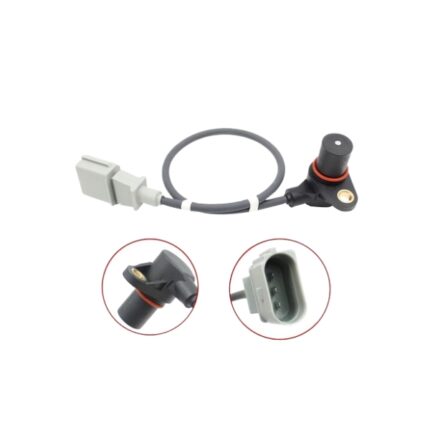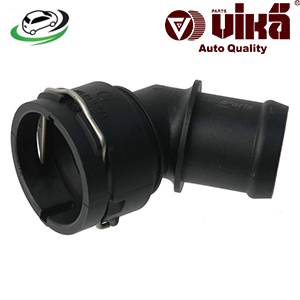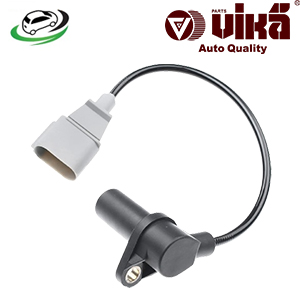Get Crankshaft Position Sensor VW Touareg 1 V8 / VW Touareg 2 V6 TDI / VW Touareg 2 V8 077905381K
The crankshaft position sensor (CKP sensor) is a vital component in modern internal combustion engines. It provides essential information about the position and rotational speed of the crankshaft, which the engine control unit (ECU) uses to regulate various engine functions. This guide explores the crankshaft position sensor in detail, covering its purpose, types, working principles, significance, and troubleshooting.
What is a Crankshaft Position Sensor?
The crankshaft position sensor is an electronic device that monitors the position and rotational speed of the crankshaft, which is the part of the engine that converts the linear motion of the pistons into rotational motion to drive the vehicle’s wheels. The CKP sensor sends this information to the ECU, which uses it to control the timing of fuel injection, ignition, and other critical engine functions.
Without accurate data from the crankshaft position sensor, the ECU would be unable to optimize engine performance, leading to issues like poor fuel efficiency, increased emissions, and potential engine damage.
Types of Crankshaft Position Sensors
There are three main types of crankshaft position sensors, each using a different method to detect the position and speed of the crankshaft:
- Magnetic Inductive Sensor:
- Working Principle: Magnetic inductive sensors use the principle of electromagnetic induction. A toothed wheel, often referred to as a reluctor, is attached to the crankshaft. As the crankshaft rotates, the teeth of the reluctor pass by the sensor, which consists of a magnet and a coil of wire. The movement of the teeth causes fluctuations in the magnetic field, inducing a voltage in the coil. This voltage is sent as a signal to the ECU.
- Common Usage: These sensors are common in older vehicles due to their durability and simplicity.
- Hall Effect Sensor:
- Working Principle: Hall effect sensors use a semiconductor to detect changes in a magnetic field. A magnet is attached to the crankshaft, and as it rotates, it passes by the sensor. The movement of the magnet alters the magnetic field, which is detected by the semiconductor and converted into an electrical signal sent to the ECU.
- Common Usage: Hall effect sensors are widely used in modern vehicles due to their accuracy, especially at low speeds.
- Optical Sensor:
- Working Principle: Optical sensors use light to determine the position of the crankshaft. A disc with slots or holes is mounted on the crankshaft, and as it rotates, the slots interrupt a light beam emitted by an LED. The interruptions are detected by a photodiode, which converts them into an electrical signal that is sent to the ECU.
- Common Usage: Although less common due to their sensitivity to dirt and debris, optical sensors are used in some specialized applications.
Function and Importance of the Crankshaft Position Sensor
The crankshaft position sensor performs several crucial functions that are essential for the proper operation of the engine:
- Timing Control:
- The sensor provides real-time data on the crankshaft’s position, allowing the ECU to precisely control the timing of fuel injection and ignition. This ensures that the engine operates at peak efficiency, delivering optimal power and fuel economy while minimizing emissions.
- Engine Synchronization:
- In multi-cylinder engines, the crankshaft position sensor helps synchronize the operation of the pistons, ensuring that they fire in the correct order. This synchronization is crucial for smooth engine operation and avoiding misfires.
- Engine Start:
- During engine startup, the CKP sensor provides the ECU with the information needed to control the ignition system. Without accurate data from the sensor, the engine may fail to start or may start erratically, leading to performance issues.
- Diagnostics:
- The CKP sensor plays a key role in engine diagnostics. If it detects any irregularities in the crankshaft’s position or speed, it sends an error code to the ECU. This code can be read using a diagnostic tool, helping mechanics identify and address issues quickly.
- Safety:
- In some vehicles, the crankshaft position sensor is integrated into safety systems. For example, if the sensor detects abnormal engine conditions, it can signal the ECU to shut down the engine to prevent further damage.
Working Principle of the Crankshaft Position Sensor
The working principle of the crankshaft position sensor involves generating an electrical signal in response to the movement of the crankshaft. Here’s how it works:
- Signal Generation:
- As the crankshaft rotates, the sensor detects the movement of a reluctor wheel, magnet, or optical disc attached to the crankshaft. The movement causes a change in the magnetic field (in magnetic and Hall effect sensors) or interrupts a light beam (in optical sensors).
- Signal Processing:
- The sensor converts the detected change into an electrical signal, which is a series of voltage pulses. The frequency and pattern of these pulses correspond to the crankshaft’s position and speed.
- Data Transmission:
- The electrical signal is transmitted to the ECU, which processes the data to determine the exact position of the crankshaft and its rotational speed.
- Engine Control:
- Based on the data received, the ECU adjusts the timing of the fuel injectors, spark plugs, and other critical engine components to ensure optimal performance.
Common Symptoms of a Failing Crankshaft Position Sensor
A failing crankshaft position sensor can cause a variety of engine issues. Some of the most common symptoms include:
- Engine Misfires:
- If the CKP sensor provides inaccurate data, the ECU may not properly synchronize the ignition timing, leading to misfires. This can result in rough idling, poor acceleration, and reduced fuel efficiency.
- Difficulty Starting the Engine:
- A faulty CKP sensor can cause the engine to struggle or fail to start. Without accurate data on the crankshaft’s position, the ECU may be unable to properly control the ignition and fuel injection systems.
- Check Engine Light:
- A malfunctioning CKP sensor often triggers the check engine light on the dashboard. The ECU will store an error code related to the sensor, which can be read using a diagnostic tool.
- Engine Stalling:
- In some cases, a failing CKP sensor can cause the engine to stall unexpectedly, especially when idling or at low speeds.
- No Spark:
- If the sensor fails completely, the ECU may not receive any signal, resulting in a no-spark condition where the engine won’t start at all.
Diagnosing and Replacing a Faulty Crankshaft Position Sensor
Diagnosing a faulty crankshaft position sensor typically involves using a diagnostic tool to read the error codes stored in the ECU. Mechanics may also use a multimeter to test the sensor’s resistance and voltage output. If the sensor is found to be defective, it will need to be replaced.
Replacement Process:
- Locating the Sensor: The crankshaft position sensor is usually mounted near the crankshaft or flywheel, often in a difficult-to-reach location. It may be located on the engine block, cylinder head, or near the timing cover, depending on the vehicle’s design.
- Removing the Old Sensor: To replace the sensor, the electrical connector must first be disconnected. Then, the mounting bolts are removed, and the sensor is carefully extracted from its position.
- Installing the New Sensor: The new sensor is installed in the reverse order. Care must be taken to ensure that the sensor is properly aligned and securely mounted to prevent future issues.
- Testing the New Sensor: After installation, the engine should be started and tested to ensure that the new sensor is functioning correctly. The check engine light should turn off, and any stored error codes should be cleared.
Importance of the Crankshaft Position Sensor
The crankshaft position sensor is a critical component that directly impacts engine performance, efficiency, and safety. Its ability to provide accurate and real-time data to the ECU is essential for the precise control of ignition timing, fuel injection, and other engine functions. A well-functioning CKP sensor helps ensure that the engine runs smoothly, delivers optimal power and fuel efficiency, and complies with emissions standards.
Follow us on Facebook for more parts.



